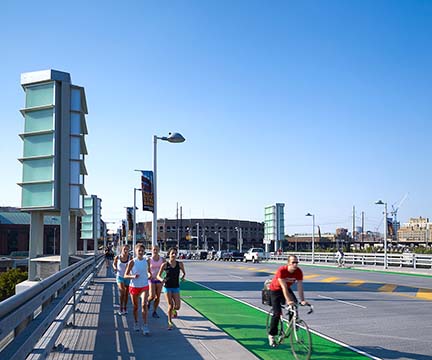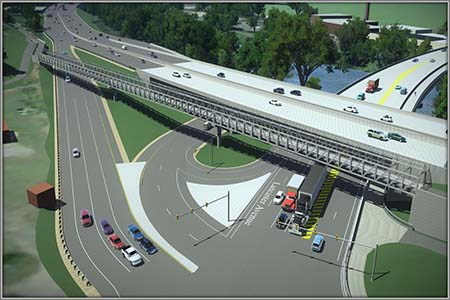The Pennsylvania Department of Transportation (PennDOT) is reaching out to communities and partner agencies to ensure that all new road projects address a broad range of needs, ranging from bicycle and pedestrian accommodation to safety and environmental stewardship.
The PennDOT Connects initiative, launched by Transportation Secretary Leslie S. Richards in December 2016, establishes a formal process to consider and document community needs for each project in the planning phase, prior to developing project scopes and cost estimates. It requires coordination with local and regional partners on all new projects, starting with those added to the 2017 transportation improvement program.

The South Street Bridge Reconstruction in Philadelphia included wider bike lines and sidewalks. Photo: PennDOT
“Our policy’s bottom line is to improve transportation through local government collaboration,” said Richards. “PennDOT Connects places a greater focus on teaming with municipal and rural planning organizations to address local community transportation needs, such as bicycle, pedestrian, and stormwater issues.” Such collaboration also can reduce costly changes later in the project development process, Richards said.
The Federal Highway Administration’s Pennsylvania Division has emphasized the benefits of the initiative.
Contextual Issue Evaluation
PennDOT Connects provides issues to consider during the outreach process:
- Safety Issues/concerns
- Stormwater management
- Transportation operation considerations
- Consistency with the long-range transportation plan
- Regional planning studies
- Right-of-way considerations
- Environmental justice
- Bicycle/Pedestrian accommodation
- Pedestrian Accessibility
- Impacts from freight
- Emergency services accommodation
- Consistency with community plans
- Other infrastructure improvements
- Anticipated public opinions
- Maintenance agreement requirements
- Transit/multimodal considerations
- Utility issues
- Planned development
- Consistency with zoning
- Impacts on natural, cultural, social environment
- Community or cultural events in project area
- Other specific regional/local topics
“The PennDOT Connects initiative is a collaborative effort to provide local communities the opportunity to meet with PennDOT to identify and discuss transportation project details unique to their goals, according to Moises Marrero, FHWA’s Assistant Division Administrator for Pennsylvania.
“This extraordinary level of collaboration at the early stages of a project ensures the effective use of taxpayer dollars by advancing safety and innovative practices, maximizing project investment, and improving the overall project delivery process,” Marrero said.
To implement the initiative, the agency has launched a new system to document local government outreach for each project on a screening form. The form requires coordination on a wide range of local planning objectives and community mobility needs such as:
- bicycle and pedestrian accommodations,
- transit access,
- freight,
- utilities,
- community health,
- stormwater management, and
- green infrastructure.
For example, for pedestrian access, the project initiation form states that dedicated pedestrian facilities should be evaluated for all highway projects. It provides a checklist allowing the user to identify the type of facility that will be accommodated, including:
- shared roadway/walkable shoulder,
- sidewalks,
- multiuse trail, or
- additional element.
If none of these apply, the form prompts the user to choose from a selection of potential reasons why pedestrian facilities will not be accommodated on the project, such as unique site constraints.
South Street Bridge Project Sets Groundwork
When PennDOT Connects was first launched, Secretary Richards pointed to Philadelphia’s South Street Bridge reconstruction project as an example of the PennDOT Connects principles, with features that incorporate “balanced elements of urban mobility.”
The original bridge replacement project was geared toward improved vehicular access. But as the community evolved over the years, there was an increased call to accommodate the significant mix of pedestrian, vehicular, and bicycle traffic, according to Chuck Davies, PennDOT Assistant District Executive for Design.
The project was changed late in the process to meet needs identified through community outreach, including meetings with neighborhood groups, city officials, and other stakeholders.
Ultimately, the project incorporated many of the features desired by the community and provided lessons that were incorporated into the PennDOT Connects approach.
“Car lanes were reduced from five to four, and speed limits were dropped from 30 mph to 25 mph. We also made the bridge more bicycle- and pedestrian-friendly with wider bike lanes and sidewalks, bike boxes to give cyclists a head start on drivers, and signal priority for walkers,” Secretary Richards said.
Projects Benefit from Early Outreach
Results of the increased outreach spurred by PennDOT Connects are visible across the state.
As of July 2018, PennDOT had collaborated with municipal officials on more than 2,000 projects, including more than 800 face-to-face meetings. These have ranged from multi-million dollar maintenance projects to a $100 million highway or bridge project.
PennDOT’s District 11 Executive Cheryl Moon-Sirianni, said PennDOT Connects “shifted our thinking—we formalized our existing coordination efforts with county and city officials and are pursuing earlier local involvement with greater collaboration.”

Community input helps PennDOT ensure connectivity of bicycle and pedestrian trails on the US 422 West Shore Bypass project. Image: PennDOT
For example, the PennDOT Connects process for the US 422 West Shore Bypass project – a five-mile highway widening and reconstruction effort in Reading (Berks County, District 5) — included a series of workshops, open houses, and meetings as well as a 21-member stakeholder workgroup to provide a collaborative voice for the community. The workgroup – which was established by the Greater Reading Chamber Alliance and the Berks County Commissioners – focused on maintaining connectivity for businesses and the community, providing effective trail access, and improving bike/pedestrian safety, according to PennDOT District 5 officials.
“We have received positive feedback from the stakeholders for soliciting their input early in the project and not just listening to their concerns, but making conscious efforts to address their concerns,” said District 5 Consultant Project Manager Earl Armitage.
At the same time, he said, balancing the differing needs of various stakeholders was the most challenging aspect of the process.
“For example, a pedestrian bridge was added to the project over Lancaster Avenue to provide grade-separated crossings for bicycles and pedestrians where an at-grade crossing was originally proposed,” he said. “This proposal is a direct result of feedback from the stakeholders.”
The stakeholders also expressed concerns with the uncontrolled pedestrian crossings at the existing cloverleaf interchange ramps at 422 and Penn Street/Penn Avenue. PennDOT is proposing an innovative diverging diamond interchange at this location, which is designed to simplify vehicular and pedestrian movements and provide signalized pedestrian crossings with “hand/man” pedestrian signal heads and countdown timers to improve pedestrian accommodations. The diverging diamond also allows for shorter pedestrian crossing distances at the signalized intersections compared to other interchange options. For the ramp(s) that will not be controlled by a traffic signal, rapid rectangular flashing beacons are proposed to notify vehicles when a pedestrian is planning on crossing the ramp.
As another example, officials pointed to the Cementon Bridge replacement project in Lehigh County.
In addition to carrying vehicular traffic over the Lehigh River, the bridge has served as a vital connection for bicycle and pedestrian uses. It is the only connection linking the Delaware and Lehigh Trail on either side of the river. For residents of Cementon, the bridge has served as the sole means for pedestrians to access the Northampton Borough business district.
PennDOT Connects offered a process for neighborhoods and agencies to discuss the importance of the bridge to the community and to find ways to maintain the links it has provided. As a result, PennDOT is proposing to add a 10-foot multipurpose trail on the new bridge with a ramp to connect to the Delaware and Lehigh Trail on both sides, maintaining bicycle and pedestrian connections for the community.
This solution is being supported by many stakeholders in the region.
Successes, Challenges, and Lessons Learned
PennDOT’s Bicycle/Pedestrian Coordinator, Roy Gothie, said PennDOT Connects “is exactly how business ought to be done.”
“PennDOT can leverage our high-level data and funding to support local knowledge and expertise as we scope, plan, design, construct and maintain a more cost-effective and safer transportation network,” Gothie said.
According to Gothie, managing the PennDOT Connects meetings adds a significant amount of work for district staff, but the meetings are well received. Staff report “a big benefit from the local knowledge and relationship building – social capital that helps things get done, even things not directly related to the ‘project-at-hand’.”
The effort also has increased interest in bicycle and pedestrian issues, including requests from metropolitan planning organizations (MPOs) and rural planning organizations (RPOs) to fund bicycle/pedestrian counters and provide data from bicycle/pedestrian tracking applications, such as Strava, Gothie said.
In addition, PennDOT has been working with the State’s health and environmental agencies to support walkable communities planning and policies – leading to more informed local planning units, stronger grant applications, and improved project scopes.
A key lesson learned: “PennDOT Connects is bigger than just the meetings with the locals and MPO/RPOs if you can leverage other departments and programs to push for a larger goal of healthy communities: economic, social, health, access, and environmental well-being,” Gothie said.
Gothie stressed that the program aimed to “develop better projects that more appropriately addressed locally identified needs in the planning and pre-scoping process so that once funded for design and construction, we’d have better cost estimates, more accurate schedules for construction, and finished projects that truly worked to support the communities.”
PennDOT expects the initiative will lead to greater process efficiencies.
“We anticipate that the identification of issues in planning – and hopefully resolving them in planning – will result in better predictability in the process,” said Brian Hare, Chief of PennDOT’s Planning and Contract Management Division.
Next Steps: Training and Outreach
Gothie said the need to provide training on the initiative for PennDOT staff, planning partners, and local governments has been a challenge, but those efforts are ongoing.
To help in that regard, PennDOT has developed the “PennDOT Connects Support Hub,” an interactive online help desk that includes guidance, a newsletter, and an online form where municipalities can sign up for technical assistance. The Hub also provides access to a series of municipal outreach sessions scheduled in each of the 12 districts across the state.
PennDOT Connects also will be integrated throughout the agency’s programs and projects as it is incorporated into applicable manuals and processes.
“By being proactive and initiating the conversations about local needs as part of our work, PennDOT can show the value in developing the local plans for cyclists and pedestrians. That planning work can help support the purpose and need statements for our projects and encourage local discussions about integrating all modes of transportation, about health outcomes of a better active transportation system, and eventually issues of equity,” Gothie said
The effort also is supporting goals set forth as the state updates its 2007 Statewide Bicycle and Pedestrian Master Plan: encouraging local planning, evaluating health and equity issues at a state level, and providing access for those who walk and bike out of necessity rather than by choice.
For more information on the initiative, link to the PennDOT Connects Website or contact Brian Hare, Chief of PennDOT’s Planning and Contract Management Division, at [email protected].